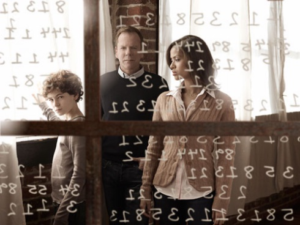
Think about all of the different people that you come in contact with on any given day: family, friends, coworkers and strangers going about their lives. The fateful hijacking of Flight 93 on 9/11 showed how a plane full of people could be connected in a way that none of the passengers could have imagined as they boarded their flights.
Is everything connected? Is the world a predictable set of patterns? Can one person really make a difference? Fox’s sci-fi television series, “Touch,” will tell stories of how unrelated people and events can be linked together, with the overall theme that one person does have the power to “touch” the world.
“People are hungry to believe that they are all connected and that what they do matters,” said Carol Barbee, executive producer of “Touch.” “I am inspired by people living their lives, doing what they love and care about. This show has a rare opportunity to tell stories about ordinary people. The best stories come from real life and anyone could be a character on the show.”
The show centers on Martin Bohm (played by Kiefer Sutherland), who is trying desperately to find a way to connect with his autistic son, Jake (played by David Mazouz). Jake is unable to speak and doesn’t like to be touched, but he does see where patterns intersect. Martin’s discovery that his son is using numbers instead of words to communicate compels him to try to put together a puzzle full of seemingly unrelated pieces.
When John Nash (played by Russell Crowe) shows his future wife, Alicia Nash (played by Jennifer Connelly) the night sky, at first all she sees is a sky full of stars until he takes her hand and traces a pattern connecting the stars. When she recognizes the pattern, Nash remarks, “Now, you are a mathematician!”
So, if numbers are like stars and mathematics is like a constellation, then it would seem that anyone can see mathematics and the patterns in everyday things.
“Mathematics sees patterns that are already there, but normally are invisible,” said Devlin. “If the show uses that idea, they would capture the very essence of mathematics.”
For example, the Fibonacci sequence follows a pattern where the first two numbers are added together to get the next number (0, 1, 1, 2, 3, 5, 8, 13, 21, 34). Fibonacci numbers are found throughout nature, such as the number of petals in a rose. Most people wouldn’t notice the mathematical patterns in these objects or identify the sequence of numbers; they would just enjoy the beauty of nature.
So, while storytellers may take poetic license with the mathematics presented, the show’s themes can bring awareness to how mathematics touches everything and connects the world, including people, in universal ways.
“I hope that viewers will come away with an awareness of the effects that they have on people and a drive to do good work in the real world,” said Barbee. “I hope people understand the power of an individual, you have no idea the power of your reach on a daily basis or how many lives you touch.”
For more such insights, log into our website https://international-maths-challenge.com
Credit of the article given to Emilie Lorditch, Inside Science News Service

